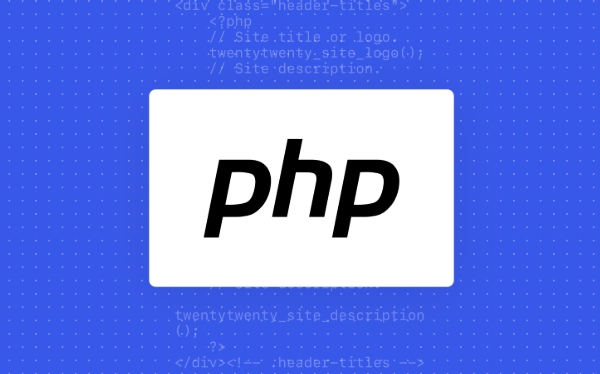It is not difficult to learn PHP from scratch. The key is to clarify the direction and follow the steps. First of all, it is necessary to clarify that PHP is mainly used for dynamic web development, which is especially suitable for interaction with databases, such as implementing user registration, login and other functions. The first step is to build an environment. It is recommended to use XAMPP or phpStudy to quickly run PHP files, and to improve efficiency with editors such as VS Code. When learning grammar, you should focus on mastering the basic structure, including conditional judgment, loops, function definitions and array operations, and you don’t have to memorize everything by rote. Finally, you need to practice through small projects, such as leaving a message book or logging into the system, contact form submission, database connection, and data addition, deletion, modification and inspection, and gradually improve your practical capabilities.

Learning PHP from scratch is not that difficult. The key is to clarify the direction and not get into the details of the grammar from the beginning. The following stages are the most important things for novices to pay attention to.

Let’s figure it out first: What is PHP used for?
Many people just started learning programming, and they heard that PHP is about to learn quickly, but they don’t know what it does. Simply put, PHP is mainly used for dynamic web development , especially dealing with databases, such as user registration, login, and message. PHP is very good at it.
Many of the blog systems you see now (such as WordPress) are written in PHP. So if your goal is to build a website backend, or want to understand how the website changes from a static page to "interactive", PHP is a good introductory language.

Step 1: Set up the environment, don't get stuck here
It is most likely for novices to get stuck in the "How to run PHP". In fact, there are many tools that can help you quickly start writing code, and you don’t need to mess around with the server at the beginning.
It is recommended that you do this:

- Install an integrated environment, such as XAMPP or phpStudy (the Chinese interface is more friendly)
- Put the written
.phpfile into the http://htdocshttp://localhost/你的文件名.php - Use a simple editor, such as VS Code, install a PHP plugin, and write code more conveniently
Don't worry about server configuration, write some code first and then run.
Learning grammar, the focus is on "using it" rather than "remembering it all"
PHP syntax is actually quite simple, such as outputting a sentence:
echo "Hello World";
There is a $ in front of the variable, and the array is used with array() or [] . These basic syntaxes can be started soon. But the mistakes that novices are prone to make are:
- Don't pay attention to the end of the semicolon
- The scope of variables is unclear
- Not proficient in array operation
It is recommended that you first master these basic structures:
- Conditional judgment (if/else)
- Loop (for / while / foreach)
- Function definition and call
- Array operations (add, delete, modify and check)
If you encounter a function you don’t understand, go to the official PHP document to check it directly, and don’t memorize it by rote.
Do a small project and don't just read the tutorial
Just reading tutorials without writing code means not learning. You can try making a simple message book or user login to the system, so you will get in touch with:
- Form Submission (GET/POST)
- Database connection (MySQL is recommended)
- Data addition, deletion, modification and query (CRUD)
For example, with the login function, you will learn how to use $_POST to receive data, and how to query the database to determine whether the username and password are correct.
Don’t pursue “perfect code” from the beginning, and let’s talk about the function first.
Basically that's it. PHP is quick to get started, but to really use it well, you still need to practice more, check more documents, and read more codes written by others. Gradually you will find that programming is actually a process of solving problems, and PHP is just a tool.
The above is the detailed content of PHP for Beginners. For more information, please follow other related articles on the PHP Chinese website!

Hot AI Tools

Undress AI Tool
Undress images for free

Undresser.AI Undress
AI-powered app for creating realistic nude photos

AI Clothes Remover
Online AI tool for removing clothes from photos.

Clothoff.io
AI clothes remover

Video Face Swap
Swap faces in any video effortlessly with our completely free AI face swap tool!

Hot Article

Hot Tools

Notepad++7.3.1
Easy-to-use and free code editor

SublimeText3 Chinese version
Chinese version, very easy to use

Zend Studio 13.0.1
Powerful PHP integrated development environment

Dreamweaver CS6
Visual web development tools

SublimeText3 Mac version
God-level code editing software (SublimeText3)
 How to handle transactions in Java with JDBC?
Aug 02, 2025 pm 12:29 PM
How to handle transactions in Java with JDBC?
Aug 02, 2025 pm 12:29 PM
To correctly handle JDBC transactions, you must first turn off the automatic commit mode, then perform multiple operations, and finally commit or rollback according to the results; 1. Call conn.setAutoCommit(false) to start the transaction; 2. Execute multiple SQL operations, such as INSERT and UPDATE; 3. Call conn.commit() if all operations are successful, and call conn.rollback() if an exception occurs to ensure data consistency; at the same time, try-with-resources should be used to manage resources, properly handle exceptions and close connections to avoid connection leakage; in addition, it is recommended to use connection pools and set save points to achieve partial rollback, and keep transactions as short as possible to improve performance.
 How to work with Calendar in Java?
Aug 02, 2025 am 02:38 AM
How to work with Calendar in Java?
Aug 02, 2025 am 02:38 AM
Use classes in the java.time package to replace the old Date and Calendar classes; 2. Get the current date and time through LocalDate, LocalDateTime and LocalTime; 3. Create a specific date and time using the of() method; 4. Use the plus/minus method to immutably increase and decrease the time; 5. Use ZonedDateTime and ZoneId to process the time zone; 6. Format and parse date strings through DateTimeFormatter; 7. Use Instant to be compatible with the old date types when necessary; date processing in modern Java should give priority to using java.timeAPI, which provides clear, immutable and linear
 Using PHP for Data Scraping and Web Automation
Aug 01, 2025 am 07:45 AM
Using PHP for Data Scraping and Web Automation
Aug 01, 2025 am 07:45 AM
UseGuzzleforrobustHTTPrequestswithheadersandtimeouts.2.ParseHTMLefficientlywithSymfonyDomCrawlerusingCSSselectors.3.HandleJavaScript-heavysitesbyintegratingPuppeteerviaPHPexec()torenderpages.4.Respectrobots.txt,adddelays,rotateuseragents,anduseproxie
 Comparing Java Frameworks: Spring Boot vs Quarkus vs Micronaut
Aug 04, 2025 pm 12:48 PM
Comparing Java Frameworks: Spring Boot vs Quarkus vs Micronaut
Aug 04, 2025 pm 12:48 PM
Pre-formanceTartuptimeMoryusage, Quarkusandmicronautleadduetocompile-Timeprocessingandgraalvsupport, Withquarkusoftenperforminglightbetterine ServerLess scenarios.2.Thyvelopecosyste,
 How does garbage collection work in Java?
Aug 02, 2025 pm 01:55 PM
How does garbage collection work in Java?
Aug 02, 2025 pm 01:55 PM
Java's garbage collection (GC) is a mechanism that automatically manages memory, which reduces the risk of memory leakage by reclaiming unreachable objects. 1.GC judges the accessibility of the object from the root object (such as stack variables, active threads, static fields, etc.), and unreachable objects are marked as garbage. 2. Based on the mark-clearing algorithm, mark all reachable objects and clear unmarked objects. 3. Adopt a generational collection strategy: the new generation (Eden, S0, S1) frequently executes MinorGC; the elderly performs less but takes longer to perform MajorGC; Metaspace stores class metadata. 4. JVM provides a variety of GC devices: SerialGC is suitable for small applications; ParallelGC improves throughput; CMS reduces
 Comparing Java Build Tools: Maven vs. Gradle
Aug 03, 2025 pm 01:36 PM
Comparing Java Build Tools: Maven vs. Gradle
Aug 03, 2025 pm 01:36 PM
Gradleisthebetterchoiceformostnewprojectsduetoitssuperiorflexibility,performance,andmoderntoolingsupport.1.Gradle’sGroovy/KotlinDSLismoreconciseandexpressivethanMaven’sverboseXML.2.GradleoutperformsMaveninbuildspeedwithincrementalcompilation,buildcac
 go by example defer statement explained
Aug 02, 2025 am 06:26 AM
go by example defer statement explained
Aug 02, 2025 am 06:26 AM
defer is used to perform specified operations before the function returns, such as cleaning resources; parameters are evaluated immediately when defer, and the functions are executed in the order of last-in-first-out (LIFO); 1. Multiple defers are executed in reverse order of declarations; 2. Commonly used for secure cleaning such as file closing; 3. The named return value can be modified; 4. It will be executed even if panic occurs, suitable for recovery; 5. Avoid abuse of defer in loops to prevent resource leakage; correct use can improve code security and readability.
 Using HTML `input` Types for User Data
Aug 03, 2025 am 11:07 AM
Using HTML `input` Types for User Data
Aug 03, 2025 am 11:07 AM
Choosing the right HTMLinput type can improve data accuracy, enhance user experience, and improve usability. 1. Select the corresponding input types according to the data type, such as text, email, tel, number and date, which can automatically checksum and adapt to the keyboard; 2. Use HTML5 to add new types such as url, color, range and search, which can provide a more intuitive interaction method; 3. Use placeholder and required attributes to improve the efficiency and accuracy of form filling, but it should be noted that placeholder cannot replace label.






